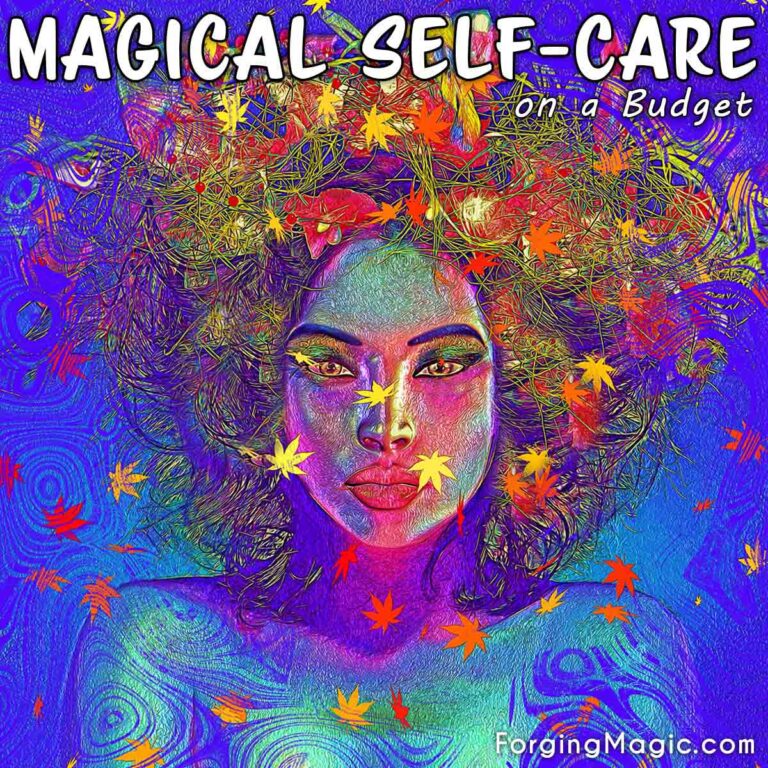Iron, Magic and Spirituality
Do you work with iron in your magical and spiritual practices? Working in a blacksmith shop, that specializes in ritual and altar tools, I often get asked about “pure iron” pieces. So today we are going to explore the history of iron and paganism. Plus how you can use it in your practice and provide some clarification on exactly what the term iron means.
Iron, Paganism and Spiritual Practices

Disclaimer: This article may contain commission or affiliate links. As an Amazon Associate I earn from qualifying purchases.
“Can you make me a ritual piece from pure iron? I want iron, not steel.”
I hear this a lot. Iron has a long history of being used in magic practices for spiritual protection and defense. So it is not surprising that we get this question a lot, but there is some misunderstanding behind this question, and I strongly believe in being completely honest with our customers. So I am going to share today the knowledge I share with people when asked this question. Hopefully it gives you a greater appreciation for your “iron” ritual tools.
Let’s start with a short and quick summary.
First, steel is still essentially (and overwhelmingly) made from iron. It varies but is usually in the range of 97%-99%+ iron! Think of it as a sleeker, more efficient form of the iron talked about by our ancestors. Second, not all steels are equal. The type of steel used during the forging process is dependent on what is being forged.
In a nutshell, if you are buying a traditionally forged piece from our Forge, it is a very high percent iron. But why can’t it be 100% iron? That’s a longer answer that took me down a lot of rabbit holes. Remember, people go to school for years to study metallurgy. What I am sharing today barely scratches the surface of this fascinating field.
What is Iron?
Iron, classically known as the Metal of Mars, has been universally perceived as the symbol of human strength, obstinacy, fortitude, honor, courage, sharpness (of body and mind), tenacity, and confidence in power.
National Library of Medicine
First, we need to provide some clarification around the term “iron”, because it is used in so many different ways, that it creates confusion for many people.
Iron is a chemical element with the symbol Fe and atomic number 26. It is one of the most abundant elements in the Earth’s crust and is found in a variety of minerals and ores, including hematite, magnetite, and taconite. It is also found in space!
Fe is a metallic element with a silver appearance. It is easy to work and shape because it is quite soft. In fact, you could cut it with a knife. It is able to conduct both heat and electricity. Iron is also ferromagnetic, which means it is strongly attracted to magnets and can be magnetized.
But “iron” can have a variety of different meanings depending on the context. Let’s explore a few of these more interesting uses of the term.
Iron and Biology
Iron also plays an important role in biology and is an essential element for life. Just ask anyone with anemia (low iron), it is very important to our bodies! Why? It is a key component of hemoglobin, the protein in red blood cells that carries oxygen from the lungs to the rest of the body. Iron is also involved in many other biological processes, including the synthesis of DNA and the functioning of the immune system. It is so important to our health!
Iron and the Cosmos
I love these tidbits about iron in the universe. This was a very deep and fascinating rabbit hole!
- It is found in the cores and atmospheres of some stars where it is created through nuclear fusion reactions. When these stars eventually run out of fuel and explode as supernovae, they release iron and other elements into space.
- It is the most abundant element in the Earth’s core. Scientists believe it is responsible for generating the planet’s magnetic field.
- Iron meteorites, which are made up almost entirely of iron and nickel, are thought to be remnants of ancient asteroids or planetoids that were destroyed in the early Solar System.
- Iron oxide, aka “rust” is what gives Mars its characteristic red appearance and why Iron has the planetary association of Mars.
- Interstellar dust contains iron and is scattered throughout the galaxy. This gives a whole new meaning to the concept that we are all star dust!
- Iron plays a significant role in the formation and composition of celestial bodies and is an important element in understanding the evolution of the universe. It is carrying the energy of all existence! This makes it a powerful tool for magic and spiritual practice.
The History of Iron
Let’s circle back to iron the metal. Archeologists believe that iron was discovered by the Hittites of ancient Egypt somewhere between 5000 and 3000 BCE. It is possible the first iron discoveries were from meteorite impacts. These discoveries changed the lives of people as they were able to make better tools and weapons.
The Iron Age began around 1200 BCE in the Mediterranean before spreading to other parts of the world. During this time, humans developed new techniques for extracting and processing iron from ores. Soon iron and the local blacksmith became key figures in communities. Often with the blacksmith being seen as having almost supernatural powers, with the way they could create using fire and metal.
Forging Iron
Here is where the pedal hits the metal… so to speak! It is not possible to forge pure iron. As we learned earlier, pure iron is a very soft and malleable metal that is quite simply not suitable for forging.
Instead, iron is alloyed to create a stronger and more durable material that is suitable for forging. The other components of the metal vary based on the purpose of the item. The most common addition is carbon to create a stronger and more rigid material. Other elements, such as chromium, nickel, and manganese, may also be used.
In traditional blacksmithing, metal is heated to a high temperature in a forge, then using a hammer, anvil, tongs and other tools the smith shapes it into a variety of creations. These techniques have been used for millennia, making blacksmithing a wonderful link with our ancestors and history.
So after all of this rambling, the takeaway is that pure iron (Fe) can not be forged. Forged ritual pieces are not pure. They are a type of steel, but many people still use both terms interchangeably.
The most important thing to know for magical purposes, your ritual pieces are powerful tools for connecting with the Earth, the Cosmos and our Ancestors.

Witchcraft, Paganism and Iron
So now we know all of this history and cool technical information, let’s chat magic!
Iron has played a significant role in spiritual beliefs and practices for thousands of years, often associated with its properties of strength, grounding, and protection. Here are some ways you can incorporate it into your ritual practice.
Sacred Element of Earth
In many pagan traditions, iron is considered a sacred metal that represents the element of earth. It is believed to possess a strong spiritual energy. Use it on your altar to bring in the element of earth and foster greater connection with spiritual energies. I love to use an iron candle holder or burning bowl. This brings the magic of the fire, which forged the iron, back full circle to the element of earth. Thus completing the energetic circle and bringing a strong grounding and balance to my work.
Warrior Spirit
Iron has the planetary association of Mars. Mars is associated with will power. If you are looking to start something new, change paths, complete something or seeking victory, Mars can support you on your quest. When doing any work invoking Mars planetary associations, iron ritual tools are a powerful ally.
Traditionally the metal of the warrior, use it when you want to invoke your inner warrior and strength. A true warrior knows when to hold back and be powerful within their strength (think of the quiet power of the Major Arcana Strength Tarot Card), it is not always the time to charge headlong into battle. Working with iron on your altar can aide you in tapping into that warrior fortitude and wisdom when dealing with situations.
Energy
Iron is extremely strong and stable. It is a fantastic energy conductor but has the unique ability to not take on negative energies. This allows it to be naturally cleansing and protective during ritual workings.
Iron is often used in the creation of ritual tools like athames and wands. These tools are used to direct energy and create protective circles during rituals.
Protection
Iron is a fantastic protective talisman. This is why many people wear it iron pendants as a protective charm. Any negative energy or magic will be attracted to the pendant then safely dispelled, protecting the wearer.
It is also believed to be a powerful tool to counteract the power of the evil eye.
You can also place nails over the entrances of your home and at the four corners to create a ward of protection. It best to use maiden nails for this practice. These are nails that are newly forged by the smith, that have never touched the ground.
In certain paths, it is believed that faeries can not touch iron. Children would be protected from being snatched by malevolent faeries by placing a nail in their pocket or on a string around their neck.
Luck and Prosperity
Horseshoes have been used for centuries for protection and to draw luck. Growing up my parents always insisted on having iron horseshoes over the entrance, points up to keep the luck in!
Anvil dust, which is a byproduct of the forging process, has traditionally been used as a talisman to draw luck in love and money.
Grounding
Iron ritual items are very grounding. Use it in rituals and ceremonies as a way to connect with the natural world and the element of earth. It will help you feel more connected to the earth and its energies.
Cleansing
Iron can be a powerful tool for cleansing. An iron burning bowl used with the smoke to cleanse energy from a space. Or an iron pentacle can be used to cleanse a tarot deck or crystals.
It’s important to note that the use of iron in witchcraft and paganism varies among different traditions and belief systems. Now you know more about iron, find ways to incorporate it into your practices and see how it works for you.








